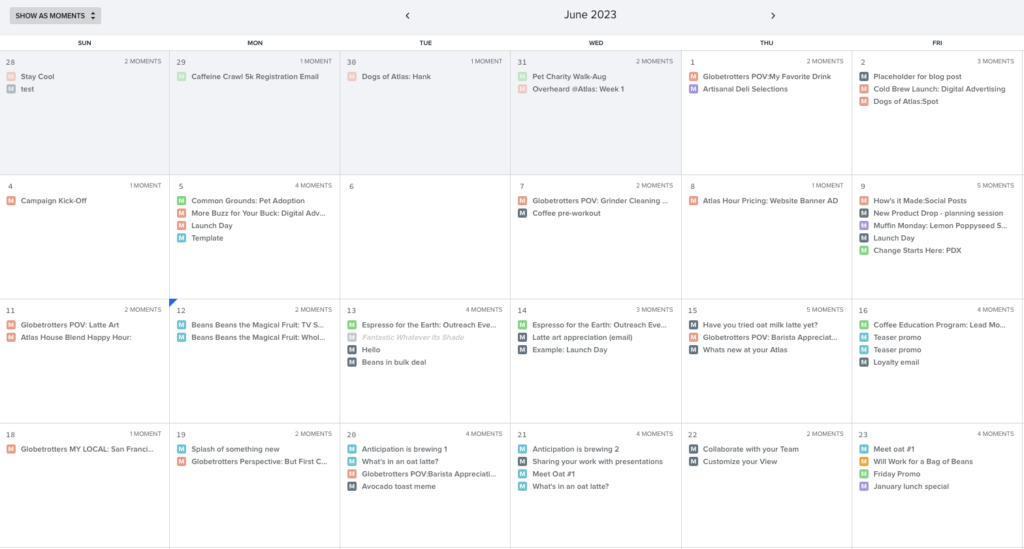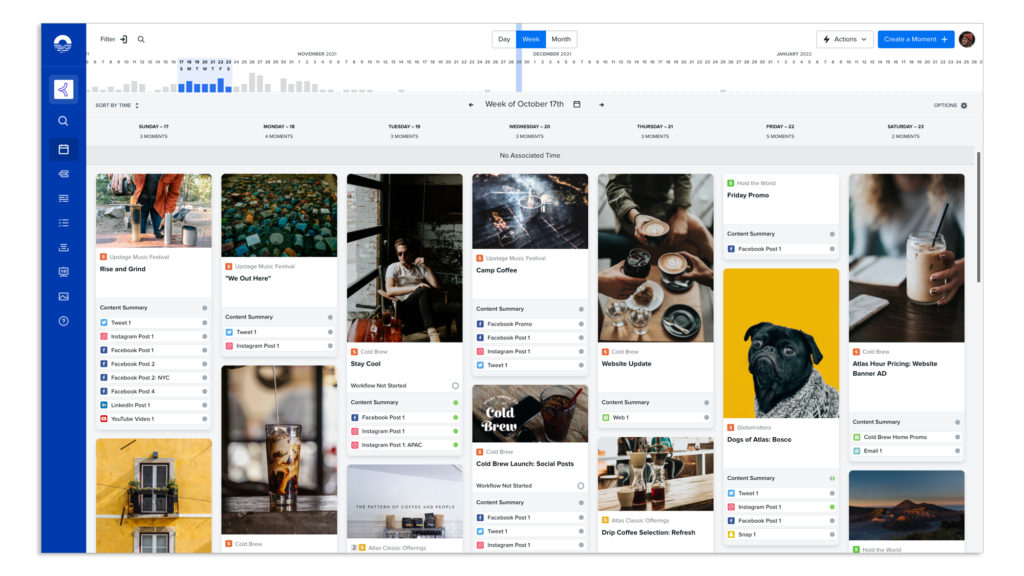by Lee Dussinger
A marketing calendar is a method for teams to make going to market easier, by visually showcasing their publication schedule. After all, bringing marketing messaging to your customer base requires careful planning, precise coordination, and full visibility. Without the right tools, this becomes far harder. An effective marketing calendar enables teams to plan more effectively and instantly understand how their brand appears in the market.
A marketing calendar (or editorial calendar) typically shows the specific content that is being published, as well as its date and channels. This differs from a strategy calendar that outlines big-picture initiatives and large-scale campaigns on a monthly or quarterly basis. We’re answering the question, “What is a marketing calendar?”, highlighting what it looks like, and showing examples of what Opal offers.
Opal is a marketing platform that brands such as Target, Starbucks, GM, and more use to bring their content to billions of people. At the center of our platform is our signature marketing calendar. This calendar delivers unparalleled visibility into what content you’re publishing, when it’s going live, and across what channels. We’re previewing our best-in-class calendar right here – however, if you’d like to explore alongside a product expert, please request a live demo right here!
What Does a Marketing Calendar Look Like?
While there is some variety in what a marketing calendar looks like, you can expect to see the same essential features on all of them. On the surface, a marketing calendar looks like any traditional calendar. However, since the calendar has the specific purpose of providing a visual representation of your brand in the market, more functions are needed than just the basics. Look for marketing-specific details, like content previews, icons for specific channels, and workflow or status.
Typically, a marketing calendar will have views for a day, week, and month. These are the common lenses through which marketers want to understand their brand in the market.
Of course, the best way to know what a marketing calendar looks like is to see examples. Here is the Opal marketing calendar broken down into day, week, and month views.
Marketing Calendar Examples: Day, Week, Month
The marketing calendar examples we’re showing you today are all the same calendar, just observed across three different views. One of the key benefits of Opal is that no matter how you filter and which lens you use, you are always seeing the central source of truth. This is the same exact calendar that the world’s largest brands trust – just built out with relevant content from the fictitious coffee brand, Atlas.
Day View

Here’s our marketing calendar example of the day view. This view is ideal for looking at content in-depth. This view shows full text, images, and placements. This view is ideal for comparing pieces of content and seeing any conflicting messages going into the market on any given day. In addition, this calendar view is often used for last-minute content approvals, as a method of double-checking prior to publication.
- Highest level of detail
- Full asset and text
- True-to-life preview
- Great for evaluating brand tone on a single day
Week View

The week view marketing calendar provides insight into what is going into the market, what channels are being utilized, and the general tone of the messaging. This calendar view provides content mockups and approximations of what time of day the content will be published. This is ideal for understanding the rhythm of how much you are talking to your audience and across what channels. In addition, this view can be helpful for finding gaps in content (for example, here we see that Friday is completely empty). This is one of the most popular views for Opal customers.
- Great for understanding content gaps and collisions
- Effective for seeing channel mix
- Large images along with content – but not full previews
- Can move content to different days and times
Month View

The most zoomed-out of our marketing calendar examples, the month view is great for understanding the editorial plans for a whole month. In the example above, we are filtering to show all Facebook content. This view can be helpful when planning new content – since you have full visibility as to what is already scheduled. In addition, this is an effective view for rescheduling and moving content around the calendar. Of course, the trade off is that this view does sacrifice some of the content detail of the day and week calendar views. However, you can double-click into any piece of content to see a full mockup of it!
- Helpful for planning
- Big-picture view of content
- Effective for seeing channel mix as well as gaps and collisions
- Helpful for moving and rescheduling content quickly
Why is a Marketing Calendar Important?
Investing time and resources into a marketing calendar delivers a variety of benefits. Both larger marketing organizations and mid-sized teams derive value from having all content on a centralized marketing calendar. Whether a calendar is the center of your workflow – or a central visualization tool – it is an essential.
Countless international campaigns from some of the world’s biggest brands are visualized on the Opal calendar.
These are the 5 major benefits of investing in a marketing calendar:
1. Finding Content Gaps & Collision – When you exclusively look at content one piece at a time, you can miss the big picture. This can lead to situations in which you have too much content publishing on a single day and holes on other days. The wrong cadence can limit the effectiveness of all of your content. Utilizing a visual marketing calendar is one of the best ways to easily understand the publishing rhythm.
2. Evaluate Tone & Topics – Seeing pieces of content side-by-side on a calendar enables you to evaluate them in context of the bigger picture. This means you can understand how the topics compare (either too similar or totally disconnected). In addition, looking at calendar placement enables you to evaluate the overall tone of your brand in a new way.
3. Visibility – In larger organizations, marketing teams are often siloed. This limits insight into what other related teams, accounts, and brands are publishing. Having all marketing efforts centralized on a shared calendar gives you all-important visibility – without requiring extra work.
4. Collaboration – By bringing the entire organization together on a central calendar, you invite opportunities for collaboration. While Opal has numerous features built for unlocking collaboration, our calendar is a popular one. Whether it is as simple as creating content to amplify other ideas, or something more elaborate, the calendar unlocks collaboration for many teams.
5. Historical Source of Truth – Sometimes the best inspiration is yourself. Looking back at previously successful campaigns and content can provide insight into what you should run next. However, when you publish thousands of pieces of content over the years, keeping a record of that content can be difficult. A purpose-built calendar is ideal as a historical source of truth!
Case Study: See how Target publishes 300+ pieces of content per day using Opal.
When upgrading to a purpose-built marketing calendar, organizations are often impressed at the impact it makes at every level. From creators trying to build content for maximum impact, to strategists protecting how the brand appears in the market, and to managers looking at the bigger picture – an effective calendar provides serious value.
Explore the Opal Calendar

Opal serves as a comprehensive marketing planning platform that has gained the trust of numerous leading brands across various industries. Brands such as Target, GM, Starbucks, and countless others all see their market on the Opal calendar before it goes live. While Opal is the perfect example of a marketing calendar, our platform also offers a purpose-built space to plan, create, and calendar content.
The earliest creative sparks are captured when teams choose to brainstorm in Opal’s collaborative space. In addition, marketing briefs and campaign plans come together in the platform for many leading brands.
When the time comes to begin workflow, Opal automatically activates the right team members at the right time. In addition, Opal’s true-to-life content previews showcase exactly what your content will look like through the eyes of your customer – as seen on the marketing calendar above.
Finally, the Opal marketing calendar delivers a host of other benefits that enables brands to hone how they go to market. Collaborate, plan, reschedule, and do much more on our central marketing calendar.
If you’re interested in transforming your marketing process, we’re here to help. Here are the options available to you:
- Request a personalized demo from one of our Opal experts. During your demo, they will guide you through the platform, demonstrating how it can effectively organize your brand’s go-to-market strategies.
- Alternatively, if you prefer a hands-on experience, you can take advantage of our free 14-day trial. This allows you to explore the platform (including the calendar) at your own pace. For some professionals and teams, seeing what the calendar looks like and how the workflows operate on their own is the best way to learn. Start your 7-day trial today!


